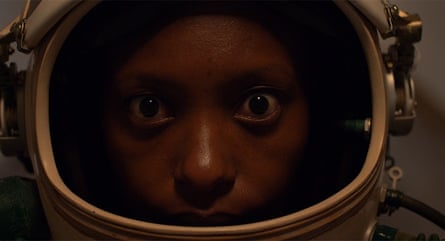There is a moment where the young black girl wandering through England in Larry Achiampong’s latest film, Wayfinder, fetches up in a fairground at dusk. Gaudy lights reflect in her eyes. An empty carousel turns before her. All of a sudden the last carriage of a ghost train hurtles noisily through the exit doors to bang into the first, which is waiting to start. The viewer is reminded of the film’s opening words: “The beginning of every story starts at the end of another.”
Circularity is the means, the message and the ruminative shape of Achiampong’s films. The British-Ghanaian artist, born in London in 1984, is perpetually roving through time and place: the past and the present, land mass and ocean, colonial and social history. He once projected an animation on a giant screen at Piccadilly Circus that could stand as his personal avatar: a figure in a helmet and suit who might come from outer space, the boy who fell to unjust Earth.
You see variations on this figure all through Achiampong’s massive show at the Baltic in Gateshead. There are 3D versions: lifesize mannequins that levitate up the walls outside a gallery full of historical video games in which the protagonist journeys through city and landscape in much the same way as the performers in the films, though at a sprightlier pace.
There are further animations, wandering along the English shoreline in a melancholy film-letter addressed by Achiampong to his own children, from whom he was separated during lockdown. And there are, above all, the boys and girls and young women who appear in the films.
A boy in a helmet gradually approaches down a long tunnel, to the voiceover of what may be his mother, desperately worried by all the different jobs he is working to send money home as an immigrant. He bends down to pick up the seashell through which, in another film, the voices of the ancestors are heard by a girl in a helmet who wanders burnt-out fields and waters by the Essex coast.

Here, there is penury and tyranny of every sort, African migrants abused in modern times just as their predecessors were during the slave trade. “To think this is the freedom we travelled so desperately over land and sea to attain.” In this particular film, Relic 3, Achiampong’s meditations are spoken over startlingly unusual images: instead of the seas of William Blake, into which human beings are thrown with unspeakable cruelty from slave ships, he shows the Essex sedge and marsh, in which their souls and cells may linger still, feeding the salt and algae.
Achiampong’s mother, arriving in Bethnal Green from Ghana long ago, finds work as a cleaner. Her son makes an elegiac tribute, in which today’s cleaners move quietly around, heads down, “invisible in the daylight hour” hauling their hoovers up and down corporate staircases, “wiping the boardroom tables on which you dictate our futures”.
She appears in person in Sunday’s Best, singing very beautifully in Ghanaian clothes in some London church where Jesus is forever white – except in Achiampong’s mind as a child, and in his eloquent script.

The artist writes, directs, shoots, produces and even scores these films, with music that ranges from choral to piano to the most gentle electronic soundtracks. In Wayfinder, he even includes his own oil paintings of the English coast and, as part of the cinematic installation, has created seats in a map of the British Isles so that you might sit on the spot of Cardiff or Edinburgh to watch the film.
This is all part of the big-hearted warmth of Achiampong’s work, which hopes to draw everyone in. His family are here, including performances by his sister as well as his mother; his friends are involved (notably the singer and composer Mataio Austin Dean, who plays the ballad-singing role of the griot in Wayfinder, a figure who “holds stories in relation to the times”). You’re invited to play the video games, sit on the maps, lie on the floor to watch. There is a pervasive tenderness and generosity.
But the feature-length Wayfinder in particular takes more patient consideration than the ambulatory to-and-fro of museums can offer. The girl in her red cape moves from Hadrian’s Wall to a Wolverhampton estate, from Margate to the National Gallery by night and a Bethnal Green cafe. The narrative musings, likewise, shift from the imaginary monologue of the young visitor from outer space to an interview with Anita Neil (Britain’s first black female Olympian), from rote theory to lyrical reminiscence.

Achiampong’s shots can be sumptuously original – a bird’s eye view of the figure moving slowly along a cliff edge; the English landscape in the most curious closeups – and the return to Bethnal Green is extremely poignant. The artist recalls his mother’s dream of buying their council flat through Thatcher’s right to buy legislation, as if this could be achieved on her cleaner’s wages. What was once a family home is now, of course, an overseas investment.
But the mesmeric meandering is occasionally hard to follow, especially the monologues – “there is an asterisk and a parenthesis that shrouds your voyage”? – and the ever-circling journey can never be allowed to culminate. It feels as if Achiampong is too modest to be more autobiographical, or can’t decide the balance between the personal and the political.
The Baltic also has a tremendous show of Chris Killip’s monochrome photographs of migrant workers trying to scavenge coal from the icy Northumbrian seas in the 1980s: wayward, spirited, devastating, unforgettable beings – and a documentary art that made each of them a legend.
Larry Achiampong: Wayfinder is at Baltic, Gateshead, until 29 October

Comments (…)
Sign in or create your Guardian account to join the discussion